|
|
2017年, 第4卷, 第2期 刊出日期:2017-04-01
|
上一期
下一期 |
|
|
|
|
|
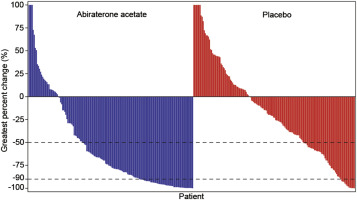
A phase 3, double-blind, randomized placebo-controlled efficacy and safety study of abiraterone acetate in chemotherapynaïve patients with mCRPC in China, Malaysia, Thailand and Russia
Dingwei Ye, Yiran Huang, Fangjian Zhou, Keji Xie, Vsevolod Matveev, Changling Li, Boris Alexeev, Ye Tian, Mingxing Qiu, Hanzhong Li, Tie Zhou, Peter De Porre, Margaret Yu, Vahid Naini, Hongchuan Liang, Zhuli Wu, Yinghao Sun
Asian Journal of Urology, 2017, 4(2): 75-85.
doi:10.1016/j.ajur.2017.01.002
 摘要
摘要
(
590 )
 PDF
PDF (2069KB)
(
153
)
Objective: This double-blind, placebo-controlled phase 3 study was designed to compare efficacy and safety of abiraterone acetate+prednisone (abiraterone) to prednisone alone in chemotherapy-naïve, asymptomatic or mildly symptomatic metastatic castrationresistant prostate cancer (mCRPC) patients from China, Malaysia, Thailand and Russia.
Methods: Adult chemotherapy-naïve patients with confirmed prostate adenocarcinoma, Eastern Cooperative Oncology Group (ECOG) performance status (PS) grade 0-1, ongoing androgen deprivation (serum testosterone <50 ng/dL) with prostate specific antigen (PSA) or radiographic progression were randomized to receive abiraterone acetate (1000 mg, QD)+prednisone (5 mg, BID) or placebo+prednisone (5 mg, BID), until disease progression, unacceptable toxicity or consent withdrawal. Primary endpoint was improvements in time to PSA progression (TTPP).
Results: Totally, 313 patients were randomized (abiraterone:n=157; prednisone:n=156); and baseline characteristics were balanced. At clinical cut-off (median follow-up time:3.9 months), 80% patients received treatment (abiraterone:n=138, prednisone:n=112). Median time to PSA progression was not reached with abiraterone versus 3.8 months for prednisone, attaining 58% reduction in PSA progression risk (HR=0.418; p<0.0001). Abirateronetreated patients had higher confirmed PSA response rate (50% vs. 21%; relative odds=2.4; p<0.0001) and were 5 times more likely to achieve radiographic response than prednisonetreated patients (22.9% vs. 4.8%, p=0.0369). Median survival was not reached. Most common (10% abiraterone vs. prednisone-treated) adverse events:bone pain (7% vs. 14%), pain in extremity (6% vs. 12%), arthralgia (10% vs. 8%), back pain (7% vs. 11%), and hypertension (15% vs. 14%).
Conclusion: Interim analysis confirmed favorable benefit-to-risk ratio of abiraterone in chemotherapy-naïve men with mCRPC, consistent with global study, thus supporting use of abiraterone in this patient population.
参考文献 |
相关文章 |
计量指标
|
|
|
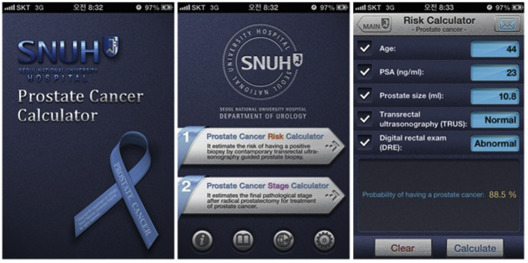
Prostate cancer screening in Europe and Asia
Kai Zhang, Chris H. Bangma, Monique J. Roobol
Asian Journal of Urology, 2017, 4(2): 86-95.
doi:10.1016/j.ajur.2016.08.010
 摘要
摘要
(
477 )
 PDF
PDF (2469KB)
(
204
)
Prostate cancer (PCa) is the second most common cancer among men worldwide and even ranks first in Europe. Although Asia is known as the region with the lowest PCa incidence, it has been rising rapidly over the last 20 years mostly due to the introduction of prostate-specific antigen (PSA) testing. Randomized PCa screening studies in Europe show a mortality reduction in favor of PSA-based screening but coincide with high proportions of unnecessary biopsies, overdiagnosis and subsequent overtreatment. Conclusive data on the value of PSA-based screening and hence the balance between harms and benefits in Asia is still lacking. Because of known racial variations, Asian countries should not directly apply the European screening models. Like in the western world also in Asia, new predictive markers, tools and risk stratification strategies hold great potential to improve the early detection of PCa and to reduce the worldwide existing negative aspects of PSA-based PCa screening.
参考文献 |
相关文章 |
计量指标
|
|
|
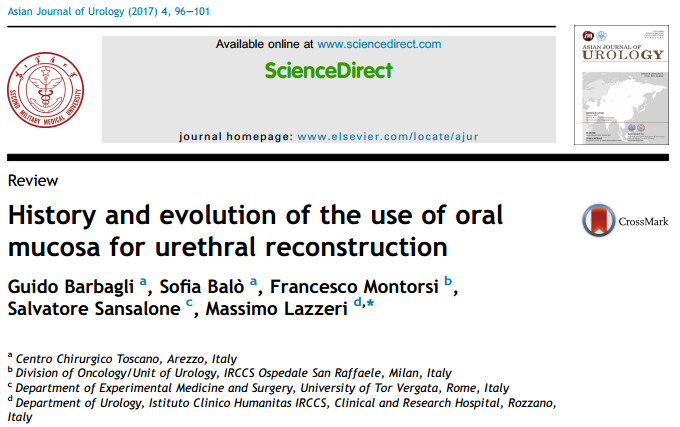
History and evolution of the use of oral mucosa for urethral reconstruction
Guido Barbagli, Sofia Balò, Francesco Montorsi, Salvatore Sansalone, Massimo Lazzeri
Asian Journal of Urology, 2017, 4(2): 96-101.
doi:10.1016/j.ajur.2016.05.006
 摘要
摘要
(
391 )
 PDF
PDF (405KB)
(
121
)
We report here the history and evolution of the use of oral mucosa in reconstructive urethral surgery since it was first used for urethroplasty in 1894. Since that time, many authors have contributed to develop, improve and popularize the use of oral mucosa as a substitute material. Paediatric urologists should be considered pioneers on the use of oral mucosa as they used it to repair primary and failed hypospadias. The use of oral mucosa to repair penile and bulbar urethral strictures was described, for the first time, in 1993. Important evolutions in the technique for harvesting oral mucosa from the cheek were reported in 1996. Today, oral mucosa is considered the gold standard material for any type of anterior urethroplasty in a one-or two-stage repair due to its biological and structural characteristics that make it a highly versatile that is adaptable to any environment required by the reconstructive urethral surgery. As the future approaches, tissue engineering techniques will provide patients with new materials originating from the oral epithelial mucosal cells, which are cultured and expanded into a scaffold. However, the path to reach this ambitious objective is still long and many difficulties must be overcome along the way.
参考文献 |
相关文章 |
计量指标
|
|
|
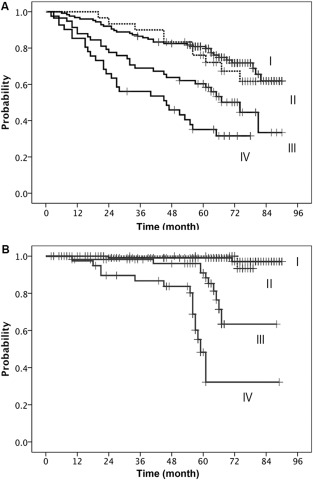
Outcomes of patients older than 75 years with non-metastatic prostate cancer
Yoshiyasu Amiya, Yasutaka Yamada, Masahiro Sugiura, Makoto Sasaki, Takayuki Shima, Noriyuki Suzuki, Hiroomi Nakatsu, Shino Murakami, Jun Shimazaki
Asian Journal of Urology, 2017, 4(2): 102-106.
doi:10.1016/j.ajur.2016.12.001
 摘要
摘要
(
388 )
 PDF
PDF (569KB)
(
204
)
Objective: Prostate cancer in elderly patients was formerly treated with androgen deprivation therapy. Since the latter of the 1990s new technologies were introduced into treatments, then strategies have varied. We aimed to observe the outcomes of elderly patients treated during transition period and compare each stage with others.
Methods: During 2008 and 2010, 255 patients with prostate cancer older than 75 years were sequentially treated. With exception of patients with bone and/or visceral metastasis, outcomes of 199 patients with localized and locally advanced stages were examined. Complete records were obtained by the end of 2015.
Results: In total, 122 (61%), 28 (14%), 37 (19%) and 12 (6%) of patients were in stages T1c-T2a, T2b-c, T3 and T4, respectively. Patients generally presented with abnormal screening or lower urinary tract symptom. Seventy-one percent of patients received androgen deprivation therapy as monotherapy and 22% of the radiation-treated patients added androgen deprivation therapy. Patients in stage T1c-T2a and T2b-c showed a favorable prognosis. Some cancer death appeared in patients with T3 and T4 during observation periods. Twenty-seven percent of patients died from prostate cancer-independent complications:pneumonia, heart disease, and brain vascular disease. Tendency is similar to that of Japanese elderly male population. No remarkable side effects from androgen deprivation therapy were noticed.
Conclusion: Elderly patients with localized prostate cancer showed favorable prognosis by androgen deprivation therapy with/without radiation, thus efficacy of androgen deprivation therapy is suitable to elderly patients with applicable stages. Prognosis of patients with locally advanced stage is serious and remains to be improved.
参考文献 |
相关文章 |
计量指标
|
|
|
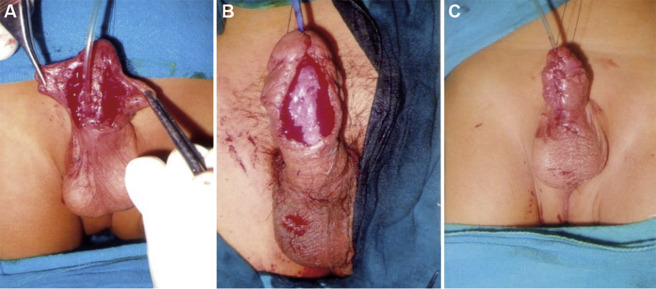
The role of tunica vaginalis flap in staged repair of hypospadias
Yogender S. Kadian, Mahavir Singh, Kamal N. Rattan
Asian Journal of Urology, 2017, 4(2): 107-110.
doi:10.1016/j.ajur.2016.11.004
 摘要
摘要
(
375 )
 PDF
PDF (837KB)
(
221
)
Objective: The surgical repair of hypospadias is done in two stages in a select group of patients with severe anomaly. The first stage (I) procedure consists of correction of penile shaft curvature and second stage (II) repair involves the creation of a neourethra. This neourethra needs a cover of an intermediate layer in order to have good functional and cosmetic results. Among the various local flaps, tunica vaginalis flap is a good option for the use as an intermediate layer.
Methods: We have managed 22 patients of chordee with hypospadias by staged repair. In Stage I, chordee correction was done by dividing the urethral plate and covering the penile shaft with dorsal prepucial flaps. In Stage II, a neourethra was created and covered with tunica vaginalis flap either through the same incision (14/22) or via a subcutaneous tunnel (8/22). An indwelling catheter was kept for 10 to 12 days.
Results: Eighteen (81.8%) patients had successful functional and cosmetic repair. Two patients (9.1%) had urethrocutaneous fistula of which one healed on subsequent dilatation while the other one (4.5%) needed repair. Overall fistula formation rate was 4.5%. In two patients, the external urinary meatus could be made upto subglanular or coronal level.
Conclusion: Staged repair of chordee with hypospadias is valuable in selected group of patients and tunica vaginalis flap is an excellent intermediate layer to cover the neourethra. However preoperative counseling is particularly essential in patients where the external urinary meatus can be created at coronal or subglanular level.
参考文献 |
相关文章 |
计量指标
|
|
|
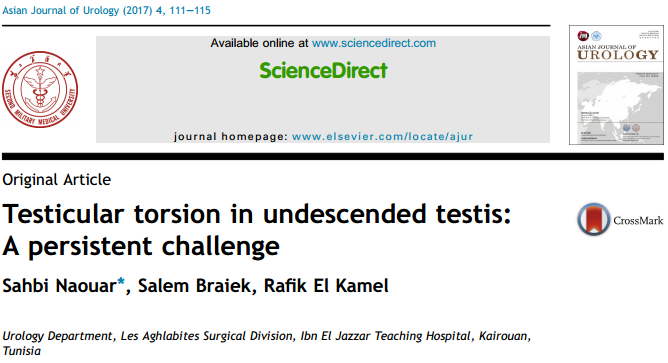
Testicular torsion in undescended testis: A persistent challenge
Sahbi Naouar, Salem Braiek, Rafik El Kamel
Asian Journal of Urology, 2017, 4(2): 111-115.
doi:10.1016/j.ajur.2016.05.007
 摘要
摘要
(
460 )
 PDF
PDF (395KB)
(
261
)
Objective: To evaluate the management and outcomes of patients who presented with torsion of an undescended testis and review the reported series in the literature.
Methods: The case records of 13 patients operated for testicular torsion involving undescended testis were retrospectively reviewed. The medical records included age at presentation, medical history, physical examination, operative findings and the results of follow-up. The diagnosis of torsion of undescended testis was made clinically and confirmed by inguinal exploration.
Results: In six cases the testis was preserved and orchiopexy was performed, while in seven cases orchidectomy was performed due to testicular gangrene in six patients and testicular tumor discovered peroperatively in one case. Mean duration of symptoms at time of surgery in the orchiopexy group was 6.5 h and in the orchidectomy group was 21.2 h. From six patients treated by orchiopexy, two patients suffered from testicular atrophy at a mean of 24 months.
Conclusion: Testicular torsion in undescended testis is still diagnosed with delay which may affect testicular salvage. The importance of examination of external genital organs is highlighted which should be routinely included by emergency physicians in physical examination for abdominal or groin pain.
参考文献 |
相关文章 |
计量指标
|
|
|
Robotic nurse duties in the urology operative room: 11 years of experience
Ali Abdel Raheem, Hyun Jung Song, Ki Don Chang, Young Deuk Choi, Koon Ho Rha
Asian Journal of Urology, 2017, 4(2): 116-123.
doi:10.1016/j.ajur.2016.09.012
 摘要
摘要
(
405 )
 PDF
PDF (2790KB)
(
122
)
The robotic nurse plays an essential role in a successful robotic surgery. As part of the robotic surgical team, the robotic nurse must demonstrate a high level of professional knowledge, and be an expert in robotic technology and dealing with robotic malfunctions. Each one of the robotic nursing team "nurse coordinator, scrub-nurse and circulating-nurse" has a certain job description to ensure maximum patient's safety and robotic surgical efficiency. Well-structured training programs should be offered to the robotic nurse to be well prepared, feel confident, and maintain high-quality of care.
参考文献 |
相关文章 |
计量指标
|
|
|
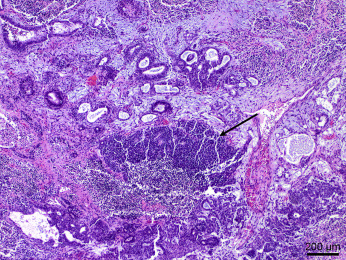
Non-seminomatous germ cell tumor with bone metastasis only at diagnosis: A rare clinical presentation
K. C. Biebighauser, Jianjun Gao, Priya Rao, Gene Landon, Lance Pagliaro, Colin P. N. Dinney, Jose Karam, Neema Navai
Asian Journal of Urology, 2017, 4(2): 124-127.
doi:10.1016/j.ajur.2016.08.004
 摘要
摘要
(
447 )
 PDF
PDF (2632KB)
(
288
)
Bone metastasis of non-seminomatous germ cell tumors (NSGCT) of the testes is a rare event and even more uncommon at initial presentation. Generally, bone lesions are discovered in the presence of concurrent retroperitoneal lymph node or visceral disease. However, in this case, a 37 years old male complaining of a growing testicular mass was found to have isolated bone metastasis with associated caudaequina syndrome without apparent abnormal findings on initial computed tomography (CT) scans. Continued neurologic symptoms prompted further evaluation with magnetic resonance imaging (MRI), which demonstrated multiple sites of bone metastasis without evidence of retroperitoneal lymph node or visceral organ involvement. This case represents a rare clinical presentation and disease manifestation of NSGCT.
参考文献 |
相关文章 |
计量指标
|
|
|
A rare presentation of cystic nephroma in a young adult
Amit Sharma, Mukund Andankar, Hemant Pathak
Asian Journal of Urology, 2017, 4(2): 128-130.
doi:10.1016/j.ajur.2017.01.001
 摘要
摘要
(
366 )
 PDF
PDF (1867KB)
(
320
)
Cystic nephroma is a rare benign renal lesion with non-specific presenting symptoms. This tumour has a bimodal age distribution presenting in children between 3 months and 2 years and in adults over 30 years of age. There is male preponderance with a 2:1 male to female ratio in the childhood whereas it is commoner in females in adults. It is uncommon in the age-group of 5 yearse-30 years. We describe a case of cystic nephroma in a 25-year-old female which was managed by partial nephrectomy.
参考文献 |
相关文章 |
计量指标
|
|
|
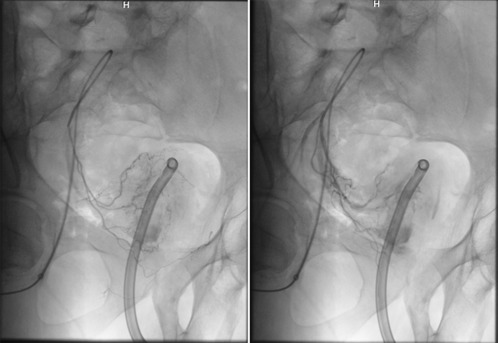
Superselective embolisation of bilateral superior vesical arteries for management of intractable hematuria in context of metastatic bladder cancer
Ahmed Saadi, Abderrazak Bouzouita, Mohamed Hedi Rebai, Mohamed Cherif, Walid Kerkeni, Haroun Ayed, Amine Derouiche, Hatem Rajhi, Riadh Ben Slama, Najla Mnif, Mohamed Chebil
Asian Journal of Urology, 2017, 4(2): 131-134.
doi:10.1016/j.ajur.2016.03.003
 摘要
摘要
(
382 )
 PDF
PDF (1083KB)
(
269
)
Hematuria due to locally advanced or metastatic bladder cancer is a common condition and is often a management problem. Percutaneous embolisation is a mini-invasive option to handle this situation. We report a case of a patient with a metastatic bladder cancer and who presented with an abundant hematuria and severe anemia. After failure of endoscopic resections and "flush" of radiotherapy haemostatic and refusal of cystectomy by the patient, he was treated by superselective embolisation of bilateral superior bladder arteries with excellent immediate results. The technique is safe and effective in the short term. The longterm effectiveness requires further investigation.
参考文献 |
相关文章 |
计量指标
|
|
|
Autonephrectomy due to urogenital tuberculosis
Rahul J. Sinha, Ankur Jhanwar, Vishwajeet Singh, Kuldeep Sharma, Gaurav Prakash, C. N. Mehrotra
Asian Journal of Urology, 2017, 4(2): 135-136.
doi:10.1016/j.ajur.2016.08.007
 摘要
摘要
(
426 )
 PDF
PDF (1168KB)
(
212
)
A 45-year-old male presented with history of left flank pain for 1 year, which was mild dull aching in nature. Plain X-ray film of the urinary tract (Fig. 1) was suggestive of diffuse calcification in the left renal area (broad arrow) along with calcification in the ipsilateral ureter region (thin arrows). Chest X-ray was normal. Non-contrast computed tomography (CT) of kidney, ureter and bladder (axial section) showed replacement of entire left kidney with calcification (Fig. 2A). After contrast injection, the left kidney was not visualised while normal contrast uptake was seen in the right kidney (Fig. 2B) (coronal section).
参考文献 |
相关文章 |
计量指标
|
|
 当期目录
当期目录
